1998 GMC SAVANA child restraint
[x] Cancel search: child restraintPage 9 of 388

Section 1 Seats and Restraint Systems
Here you’ll find information about the seats in your vehicle\
and how to use your safety belts properly. You can also
learn about some things you should
not do with air bags and safety belts.
1-2 1-11
1-16
1- 17
1-17
1-25
1-26
1-26 1-34 Seats and Seat Controls
Safety Belts: They’re for Everyone
Here Are Questions Many People Ask About Safety Belts
-- and the Answers
How to Wear Safety Belts Properly
Driver Position Safety Belt Use During Pregnancy
Right Front Passenger Position
Air Bag System
Rear Seat Passengers 1-37
1-39
1-41
1-46
1-58 1-61
1-61
1-62 Rear Safety Belt Comfort Guides for Children
and Small Adults
Center Passenger Position
Children Child Restraints
Larger Children
Safety Belt Extender
Checking Your Restraint Systems
Replacing Restraint System Parts After
a Crash
ProCarManuals.com
Page 25 of 388
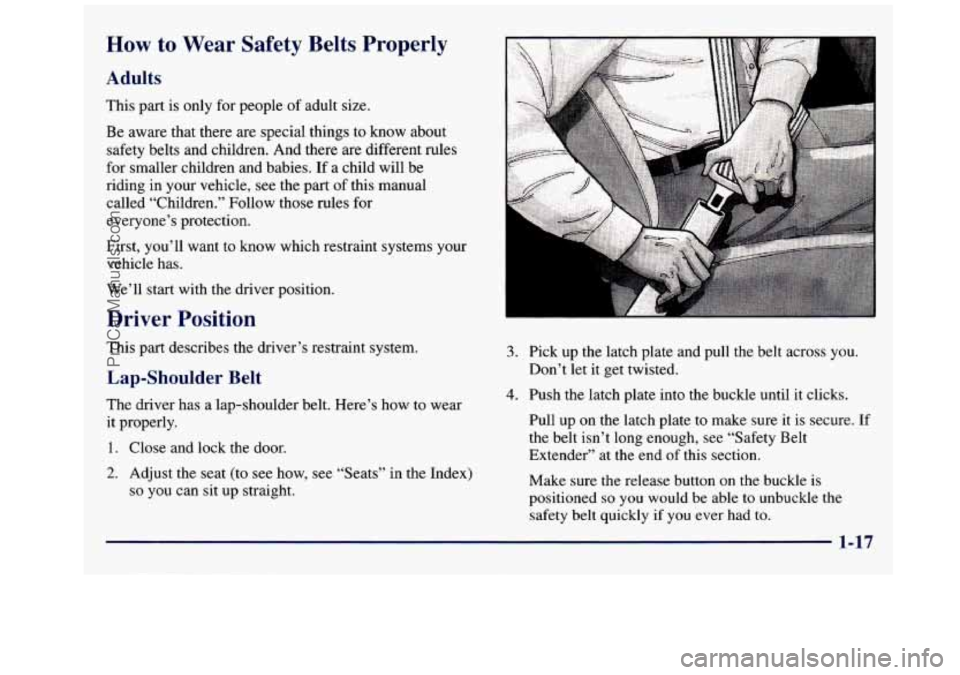
How to Wear Safety Belts Properly
Adults
This part is only for people of adult size.
Be aware that there are special things to know about
safety belts and children. And there
are different rules
for smaller children and babies.
If a child will be
riding in your vehicle, see the part
of this manual
called “Children.” Follow those rules for
everyone’s protection.
First, you’ll want to know which restraint systems your vehicle has.
We’ll start with the driver position.
Driver Position
This part describes the driver’s restraint system.
Lap-Shoulder Belt
The driver has a lap-shoulder belt. Here’s how to wear
it properly.
1. Close and lock the door.
2. Adjust the seat (to see how, see “Seats” in the Index)
so you can sit up straight.
3. Pick up the latch plate and pull the belt across you.
4. Push the latch plate into the buckle until it clicks.
Don’t
let it get twisted.
Pull
up on the latch plate to make sure it is secure. If
the belt isn’t long enough, see “Safety Belt
Extender” at the end
of this section.
Make sure the release button on the buckle is
positioned
so you would be able to unbuckle the
safety belt quickly
if you ever had to.
1-17
ProCarManuals.com
Page 34 of 388
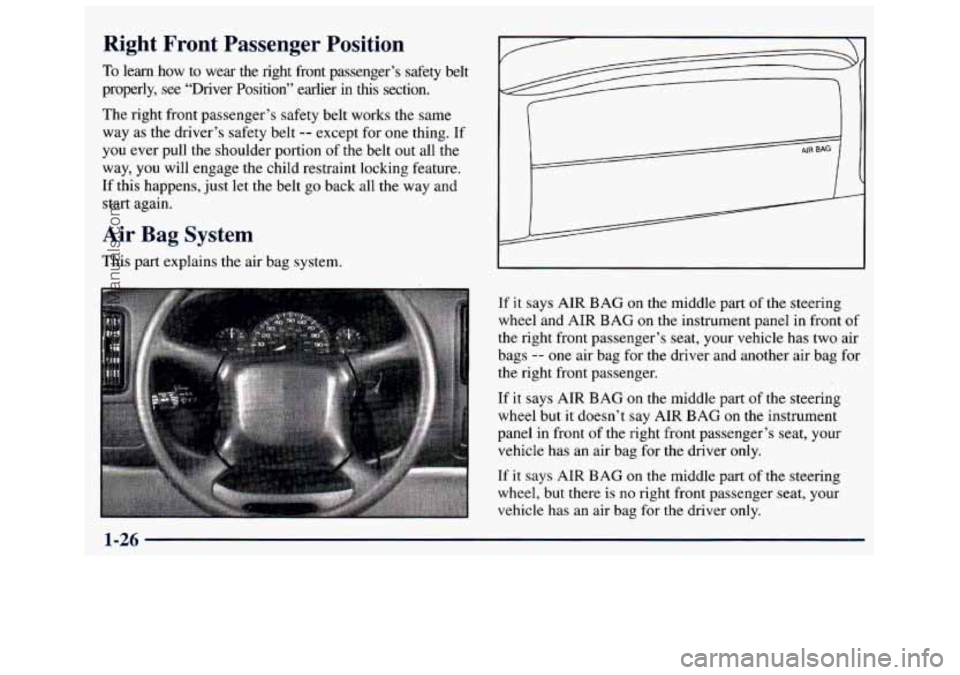
Right Front Passenger Position
To learn how to wear the right front passenger’s safety belt
properly, see “Driver Position” earlier in this section.
The right front passenger’s safety belt works the same
way as the driver’s safety belt
-- except for one thing. If
you ever pull the shoulder portion of the belt out all the
way, you will engage the child restraint locking feature.
If this happens, just let the belt
go back all the way and
start again.
Air Bag System
This part explains the air bag system.
If it says AIR BAG on
the middle part of the steering
wheel and AIR BAG
on the instrument panel in front of
the right front passenger’s seat, your vehicle has two air
bags
-- one air bag for the driver and another air bag for
the right front passenger.
If it says AIR BAG on the middle part of the steering
wheel but it doesn’t say AIR BAG on the instrument
panel in front of the right front passenger’s seat, your
vehicle has an air bag for the driver only.
If
it says AIR BAG on the middle part of the steering
wheel, but there is no right front passenger seat, your
vehicle has an air bag for
the driver only.
1-26
ProCarManuals.com
Page 36 of 388
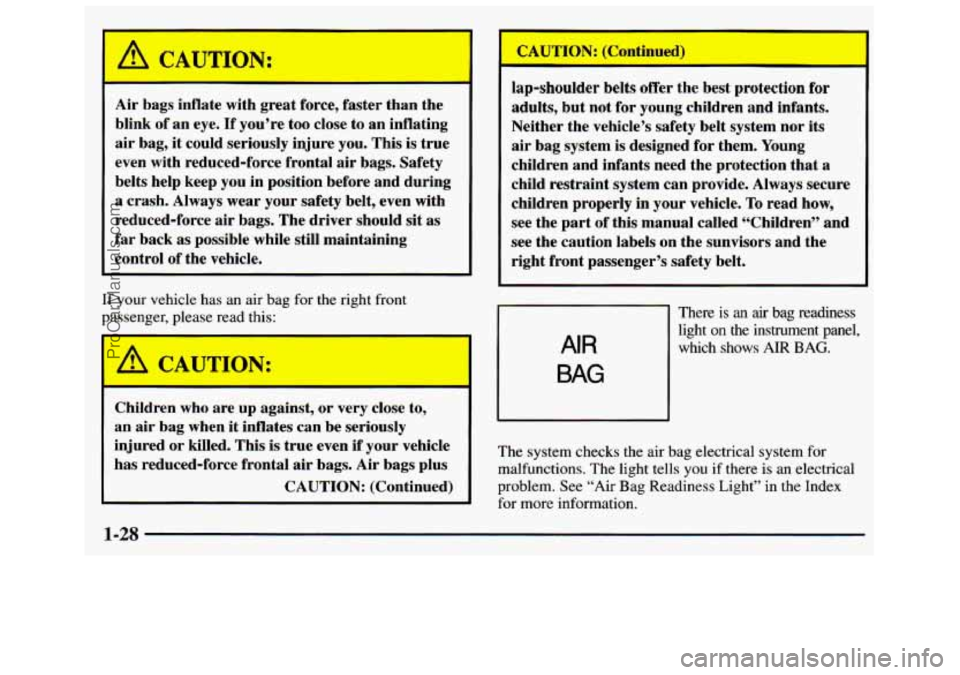
Air bags inflate with great force, faster than the
blink of an eye.
If you’re too close to an inflating
air bag, it could seriously injure you. This
is true
even with reduced-force frontal air bags. Safety
belts help keep you in position before and during
a crash. Always wear your safety belt, even with
reduced-force air bags. The driver should sit as
far back as possible while still maintaining
control of the vehicle.
If your vehicle has an air bag for the right front
passenger, please read this:
I
Children who are up against, or very close to,
an air bag when it inflates can be seriously
injured or killed. This
is true even if your vehicle
has reduced-force frontal air bags.
Air bags plus
CAUTION: (Continued) lap-shoulder
belts offer the best protection
for
adults, but not for young children and infants.
Neither the vehicle’s safety belt system nor its
air bag system is designed for them. Young
children and infants need the protection that a
child restraint system can provide. Always secure
children properly in your vehicle.
To read how,
see the part
of this manual called “Children” and
see the caution labels on the sunvisors and the
right front passenger’s safety belt.
31 There is an air bag readiness
AIR
light on the instrument panel,
which shows
AIR BAG.
BAG
The system checks the air bag electrical system for
malfunctions. The light tells you if there
is an electrical
problem. See “Air Bag Readiness Light” in the Index
for more information.
1-28
ProCarManuals.com
Page 45 of 388
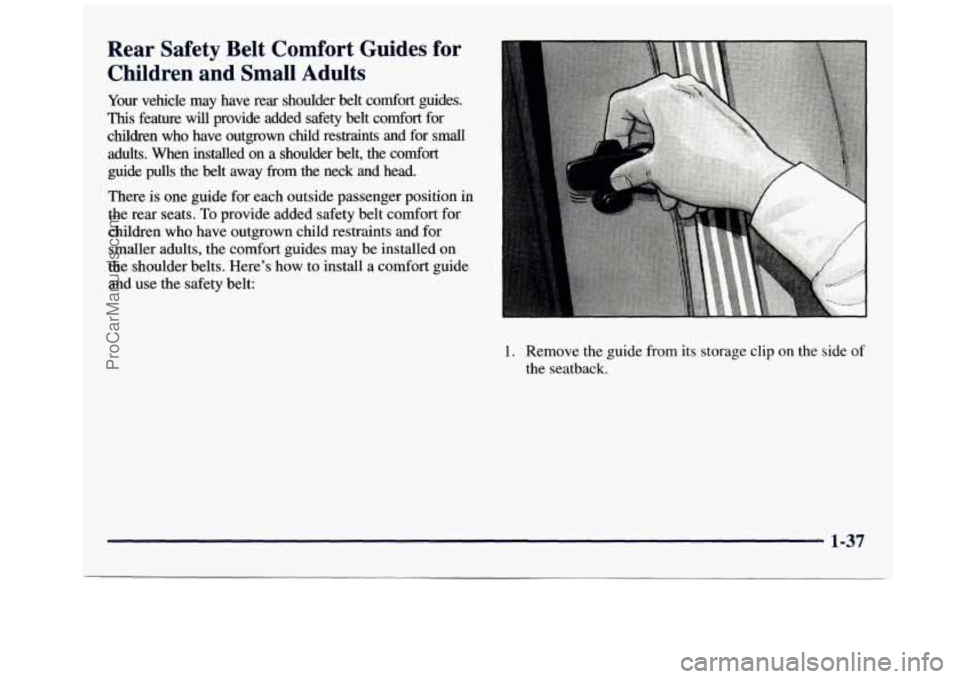
Rear Safety Belt Comfort Guides for Children and Small Adults
Your vehicle may have rear shoulder belt comfort guides.
This feature will provide added safety belt comfort for
children who have outgrown child restraints and for small
adults. When installed
on a shoulder belt, the comfort
guide pulls the belt away
from the neck and head.
There is one guide for each outside passenger position in
the rear seats.
To provide added safety belt comfort for
children who have outgrown child restraints and for
smaller adults, the comfort guides may be installed on
the shoulder belts. Here’s how to install a comfort guide
and use the safety belt:
1. Remove the guide from its storage clip on the side of
the seatback.
1-37
ProCarManuals.com
Page 49 of 388
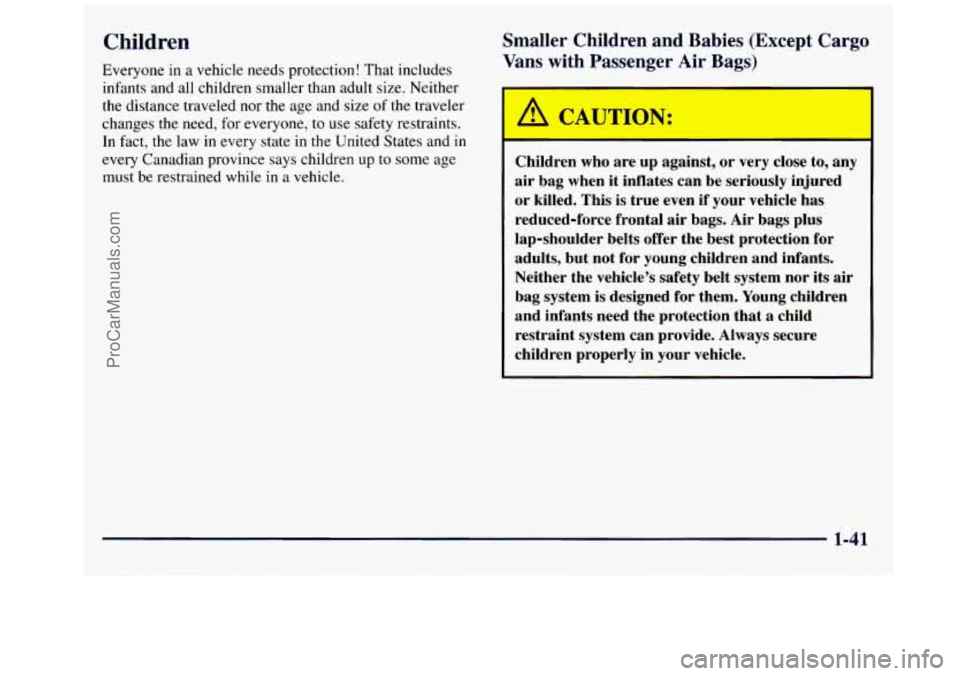
Children
Everyone in a vehicle needs protection! That includes
infants and all children smaller than adult size. Neither
the distance traveled nor the age and size of the traveler
changes the need, for everyone,
to use safety restraints.
In fact, the law in every state in the United States and in
every Canadian province
says children up to some age
must be restrained while
in a vehicle.
Smaller Children and Babies (Except Cargo
Vans
with Passenger Air Bags)
Children who are up against, or very close to, any
air bag when it inflates can be seriously injured
or killed. This
is true even if your vehicle has
reduced-force frontal air bags.
Air bags plus
lap-shoulder belts offer the best protection for
adults, but not for young children and infants.
Neither the vehicle’s safety belt system nor its air
bag system is designed for them. Young children
and infants need the protection that a child
restraint system can provide. Always secure
children properly in your vehicle.
1-41
ProCarManuals.com
Page 50 of 388
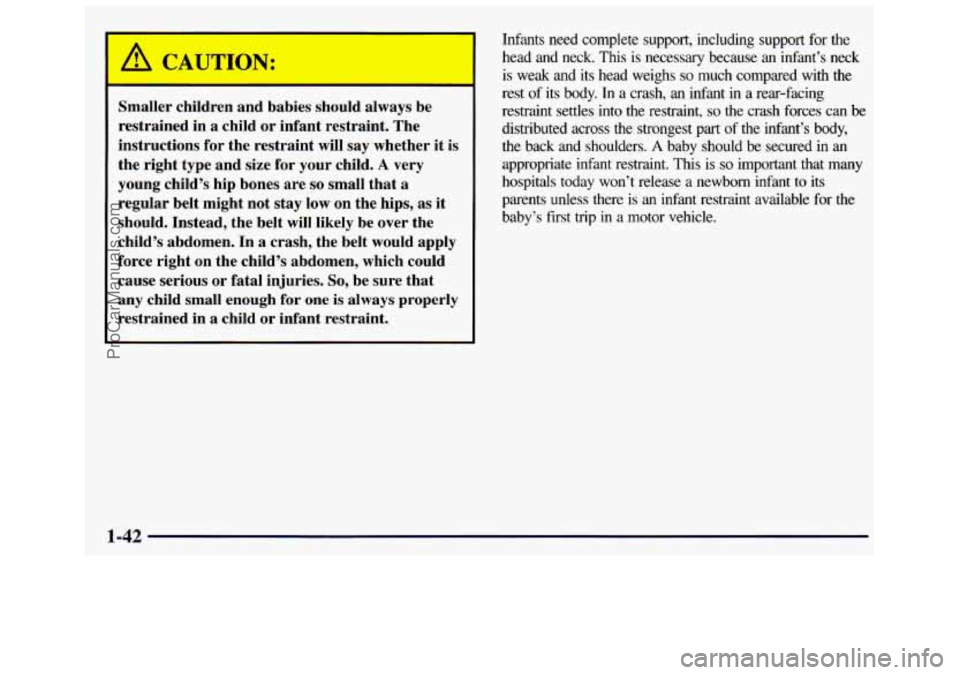
A CAUTION:
Smaller children and babies should always be
restrained in a child or infant restraint. The
instructions for the restraint will say whether it is
the right type and size for your child.
A very
young child’s hip bones are
so small that a
regular belt might not stay low
on the hips, as it
should. Instead, the belt
will likely be over the
child’s abdomen. In a crash, the belt would apply
force right on the child’s abdomen, which could
cause serious or fatal injuries.
So, be sure that
any child small enough for one
is always properly
restrained in a child or infant restraint.
Infants need complete support, including support for the
head and neck. This is necessary because an infant’s neck
is weak and its head weighs so much compared with the
rest
of its body. In a crash, an infant in a rear-facing
restraint settles into the restraint,
so the crash forces can be
distributed across the strongest
part of the infant’s body,
the back and shoulders.
A baby should be secured in an
appropriate infant restraint.
This is so important that many
hospitals today won’t release
a newborn infant to its
parents unless there is
an infant restraint available for the
baby’s first trip
in a motor vehicle.
1-42
ProCarManuals.com
Page 52 of 388

Smaller Children and Babies (Cargo Vans
with Passenger Air Bags)
Children who are up against, or very close to, any
air bag when it inflates can be seriously injured
or killed. This is true even if your vehicle has
reduced-force frontal air bags. Air bags plus
lap-shoulder belts offer the best protection for
adults, but not for young children and infants.
Neither the vehicle’s safety belt system nor its air
bag system is designed for them. Young children
and infants need the protection that a child
restraint system can provide. Always secure
children properly in your vehicle.
A very young child’s hip bones are so small that a
regular belt might not stay low on the hips,
as it
should. Instead, the belt will likely be over the
child’s abdomen. In a crash, the belt would apply
force right on the child’s abdomen, which could
cause serious or fatal injuries. Smaller children
and babies should always be restrained in a child
restraint. However, infants, who should be
restrained in a rear-facing child restraint, cannot
ride safely in this vehicle. The instructions for the
restraint will say whether it
is the right type and
size for your child.
If a forward-facing child
restraint is suitable for your child, be sure the
child is always properly restrained while riding in
this vehicle.
1-44
ProCarManuals.com